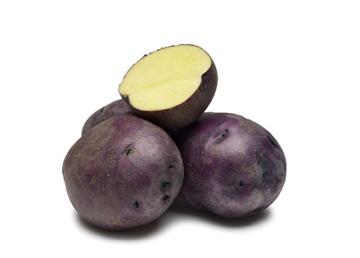Striking (Huckleberry) Gold

With its signature purple skin, yellow flesh, and small size, the Huckleberry Gold potato, co-developed by ARS, is gaining popularity with consumers and niche markets alike. (Photo courtesy of PVMI.org)
When the New York Times’ food and wine writer waxes poetic about your potato—“Inside the Huckleberry Gold’s purple jacket is a fine-textured potato with rich flavor”—you know you may have a winner on your hands… or at least on the dinner table!
The “you” in this case happens to be Agricultural Research Service’s (ARS) Small Grains and Potato Germplasm Research Unit in Aberdeen, Idaho, and the potato—Huckleberry Gold—is a variety with purple skin and yellow flesh whose culinary qualities are similar to those of the Yukon Gold. But it has lower sucrose and vitamin C content and a significantly higher level of antioxidants than Yukon Gold, thereby conferring greater health benefits. It’s also smaller than Yukon Gold, giving it better access to specialty markets geared toward smaller size.
Interest in specialty potato varieties has increased over the years, with consumers seeming to prefer varieties with purple skin and yellow flesh over those with red skin and yellow flesh.
Huckleberry Gold was originally designated as breeding line A99326-1PY, and it originated from hybridization in 1999 by ARS Aberdeen staff between Agria and COA94019-5R. Agria is a yellow-fleshed German variety, and COA94019-5R is a red-skinned, white-fleshed breeding clone originating from the Colorado State University potato breeding program that was subsequently selected in the field at Aberdeen, Idaho.
First selected in the field in 2003, Huckleberry Gold went through multiple evaluations and trials and was officially released in 2011 from the Northwest (Tri-State) Potato Variety Development Program, which is composed of researchers from the ARS, University of Idaho, Oregon State University, and Washington State University.
Huckleberry Gold also is very resistant to Potato virus X and the golden potato cyst nematode and has moderate resistance to common scab and dry rot.
Do an Internet search on “Huckleberry Gold,” and you’ll see quite a smorgasbord of entries: catalogs from seed producers and farms, recipes, foodie articles, and scientific and technical literature. The variety appears to be rather versatile. Besides its regal purple skin, yellow flesh, smaller size, and rich flavor, the fact that it has a lower glycemic index appears to have carved out a niche attracting consumers who wish to reduce sugar intake. With Huckleberry Gold, many consumers can have the proverbial cake (or potato) and eat it, too. -- By Mina Chung, ARS Office of Communications.
You May Also Like

